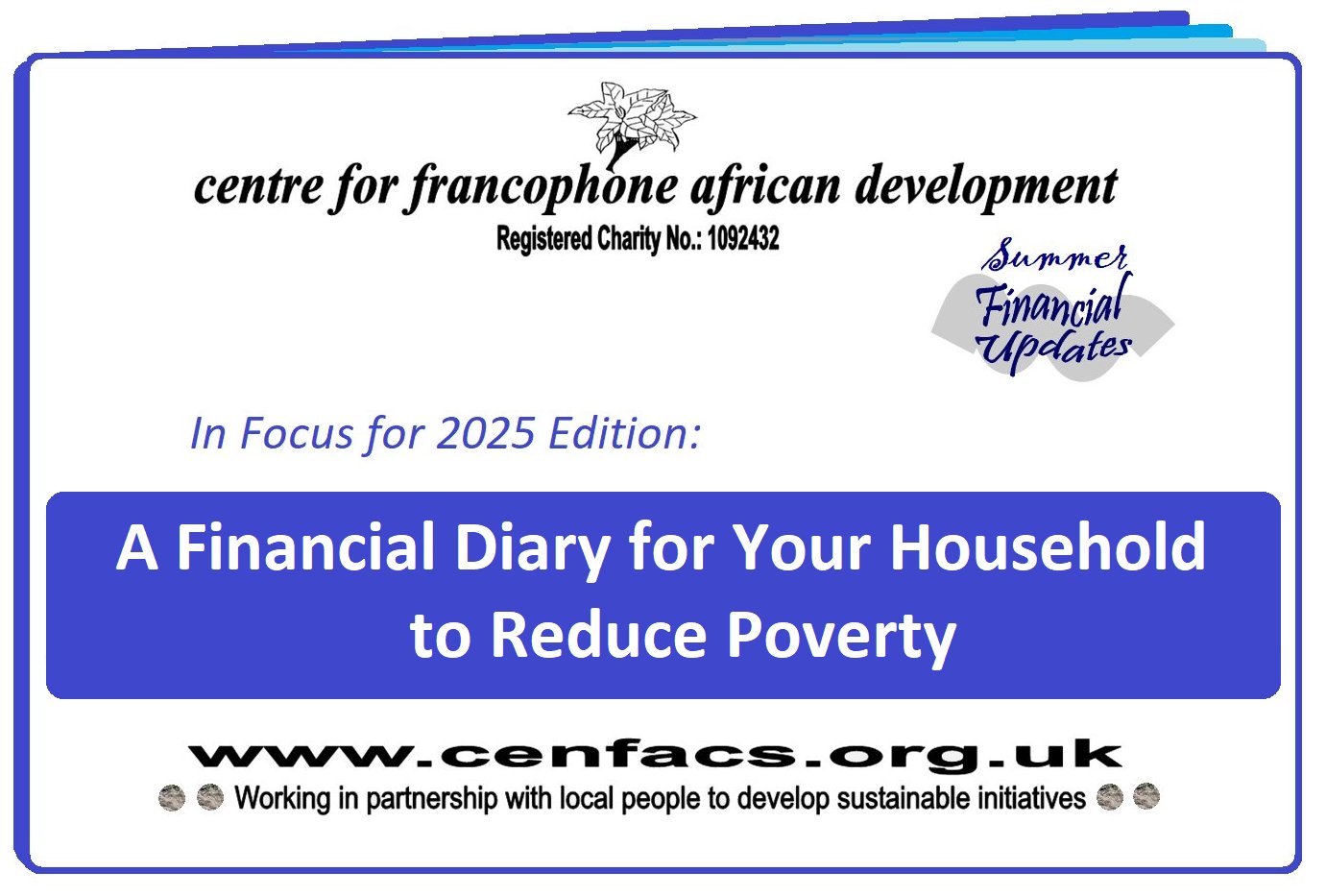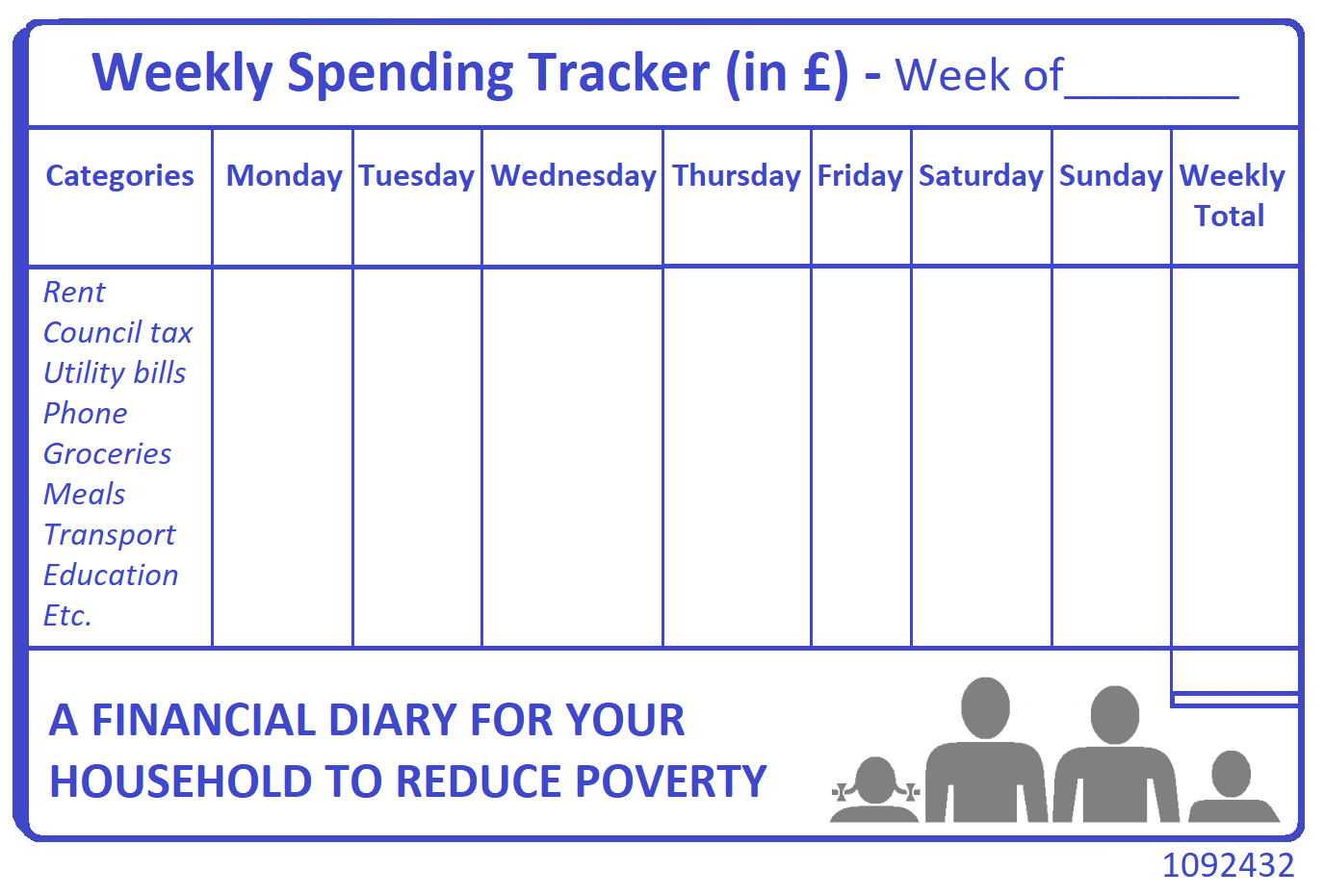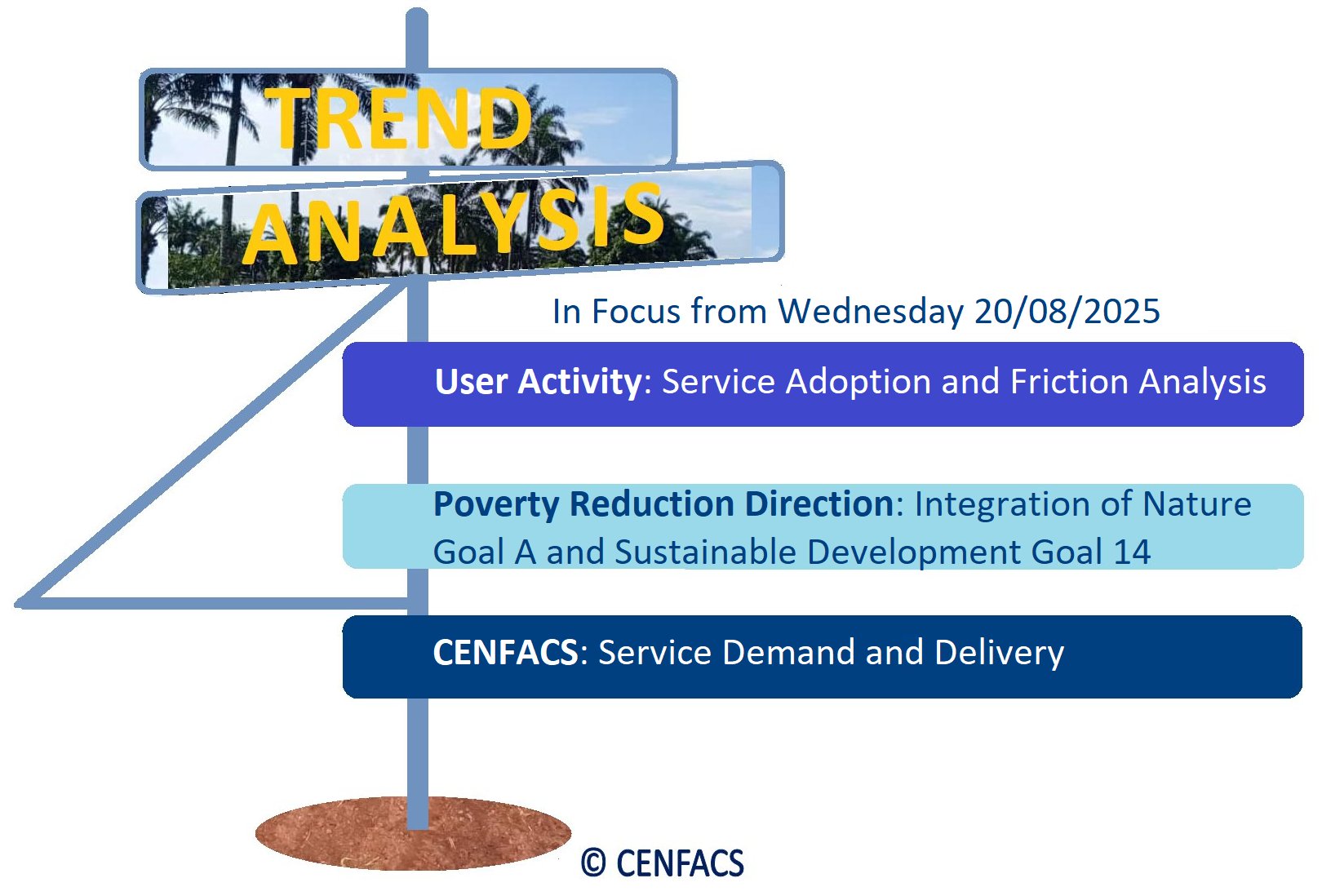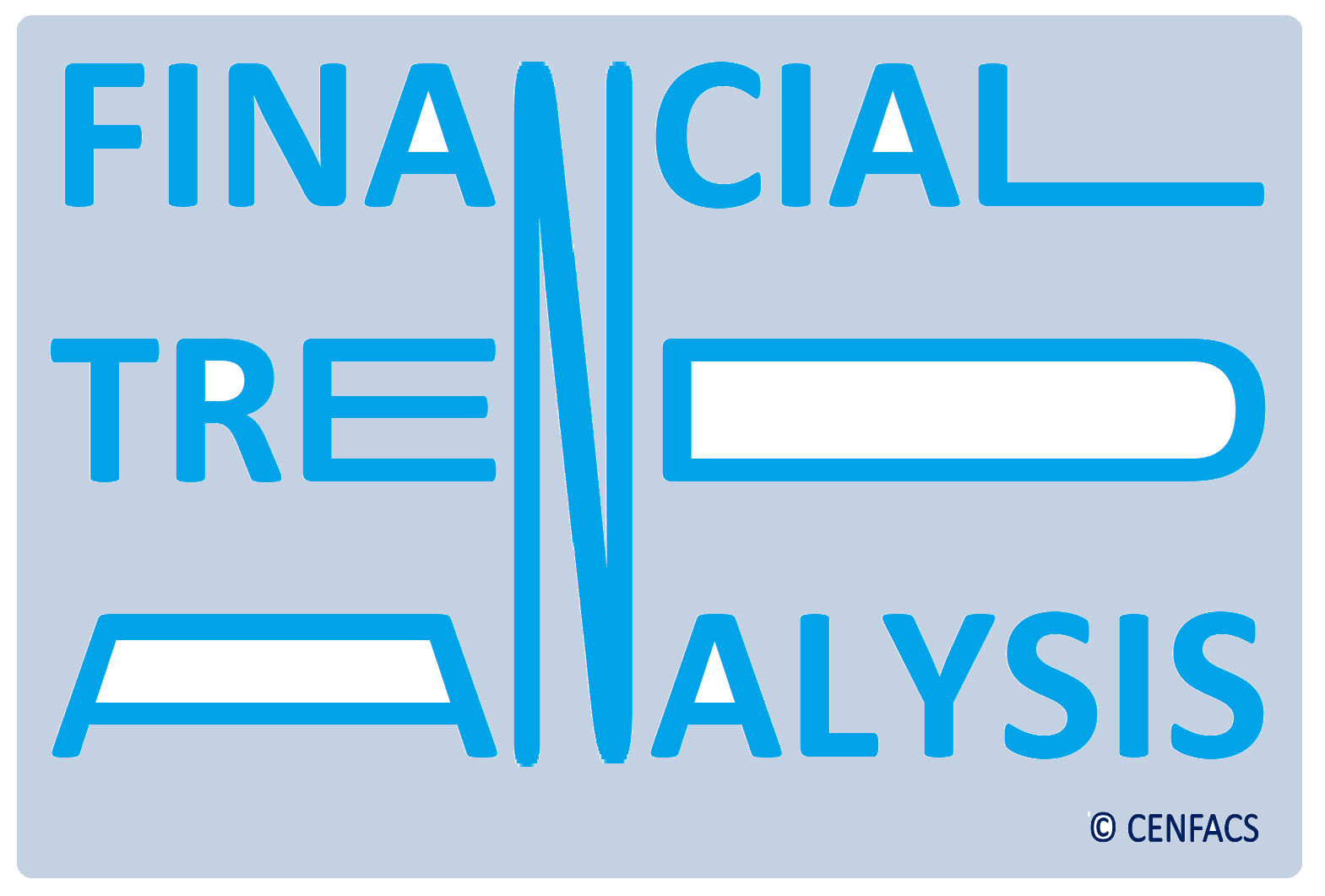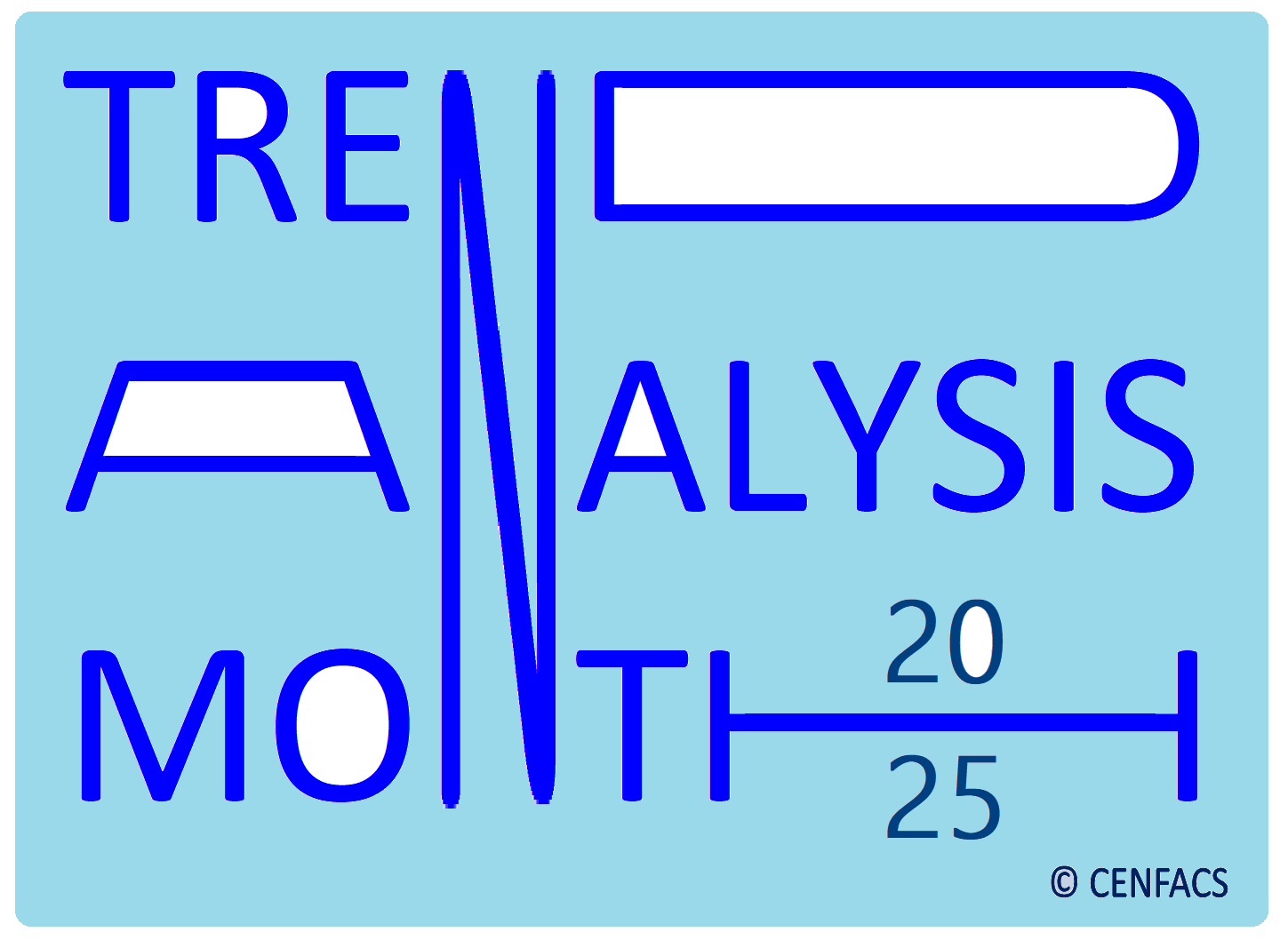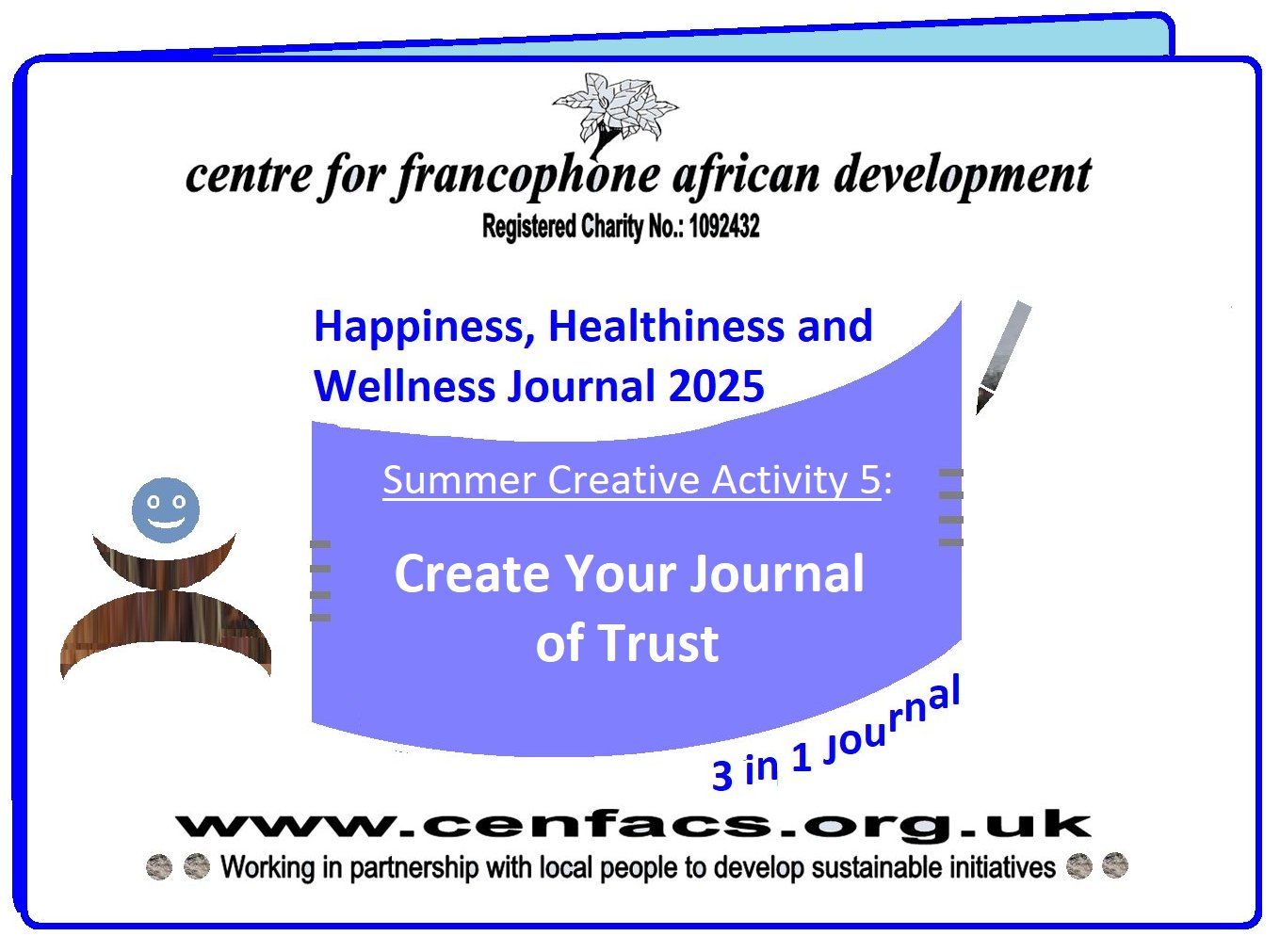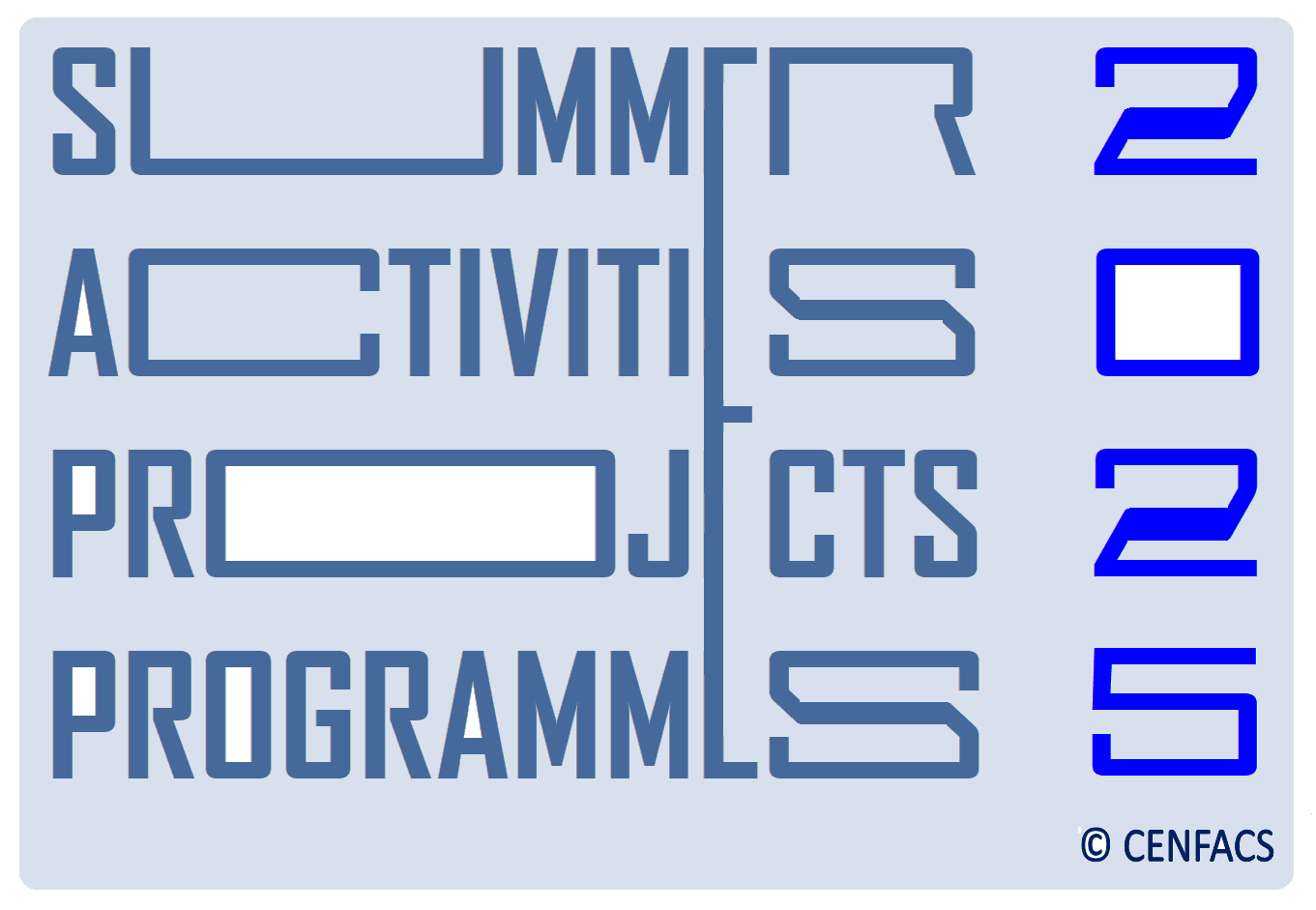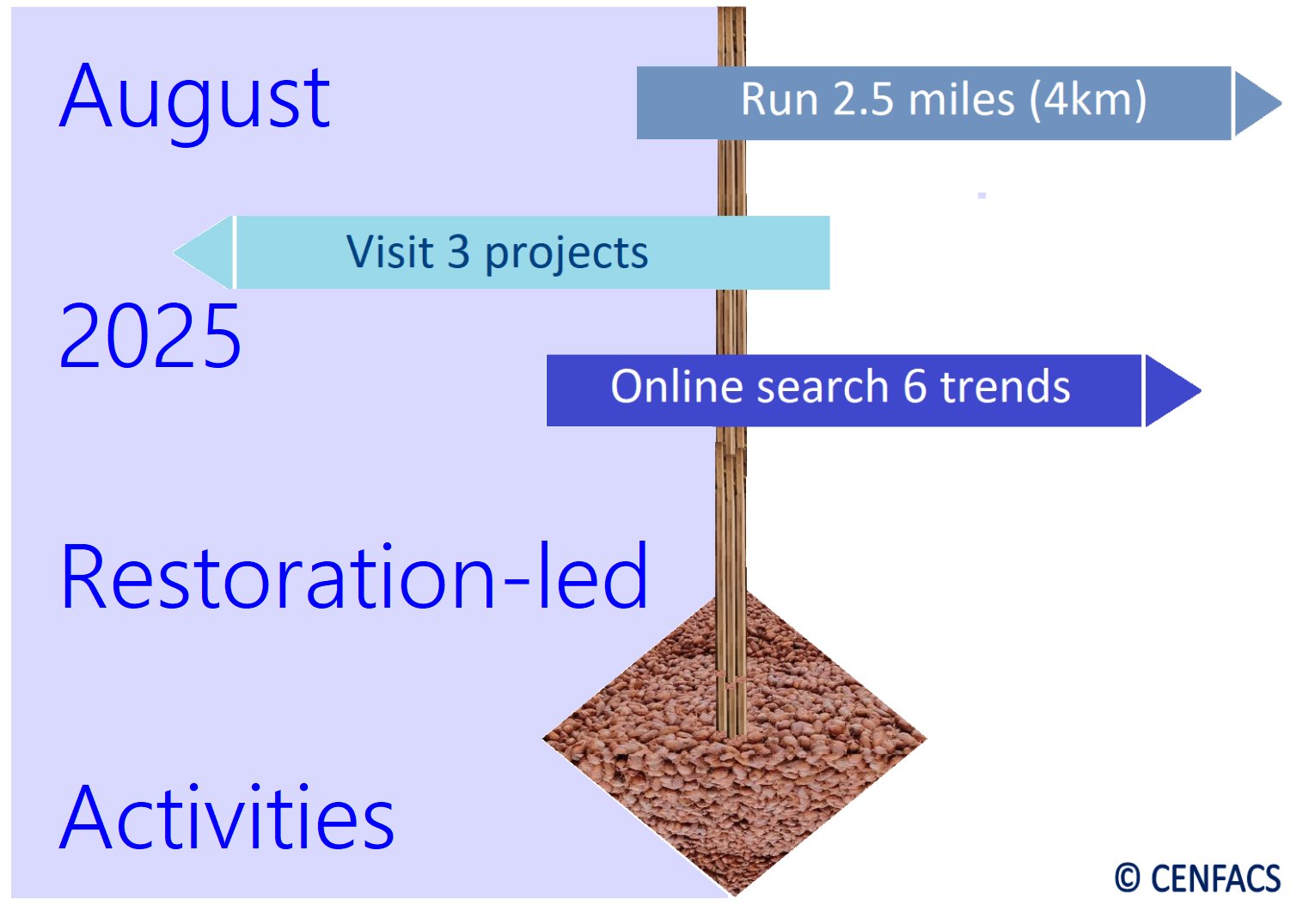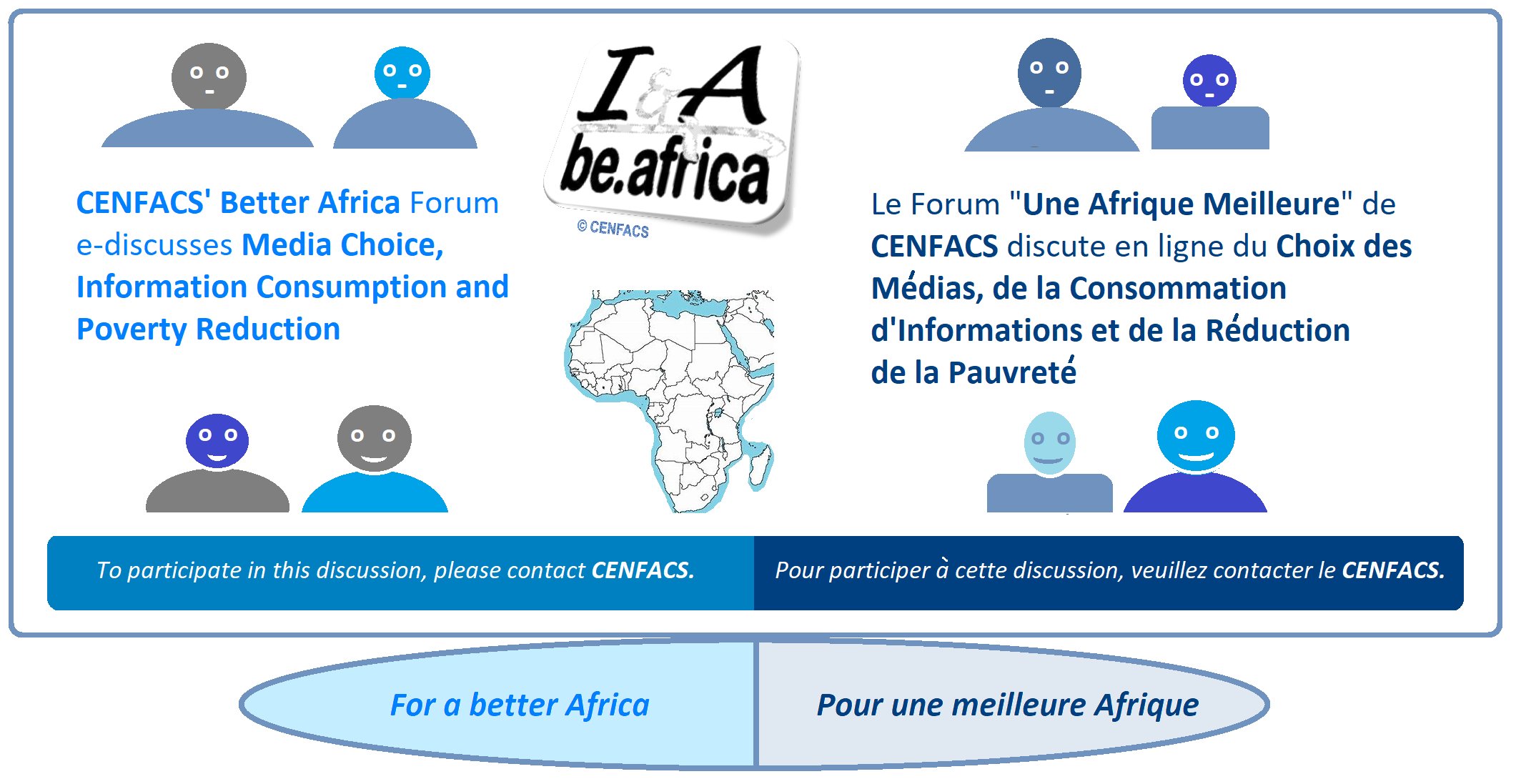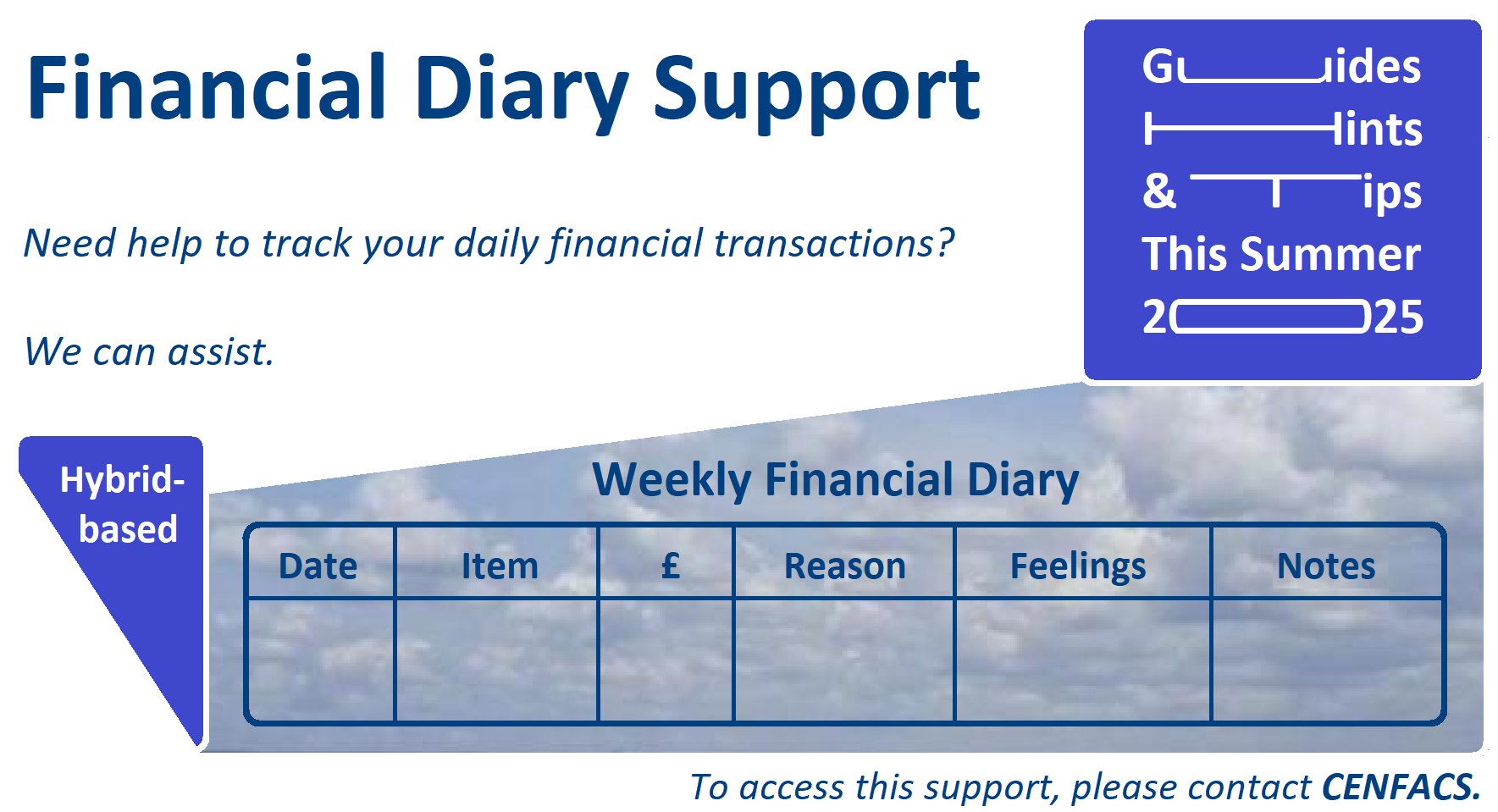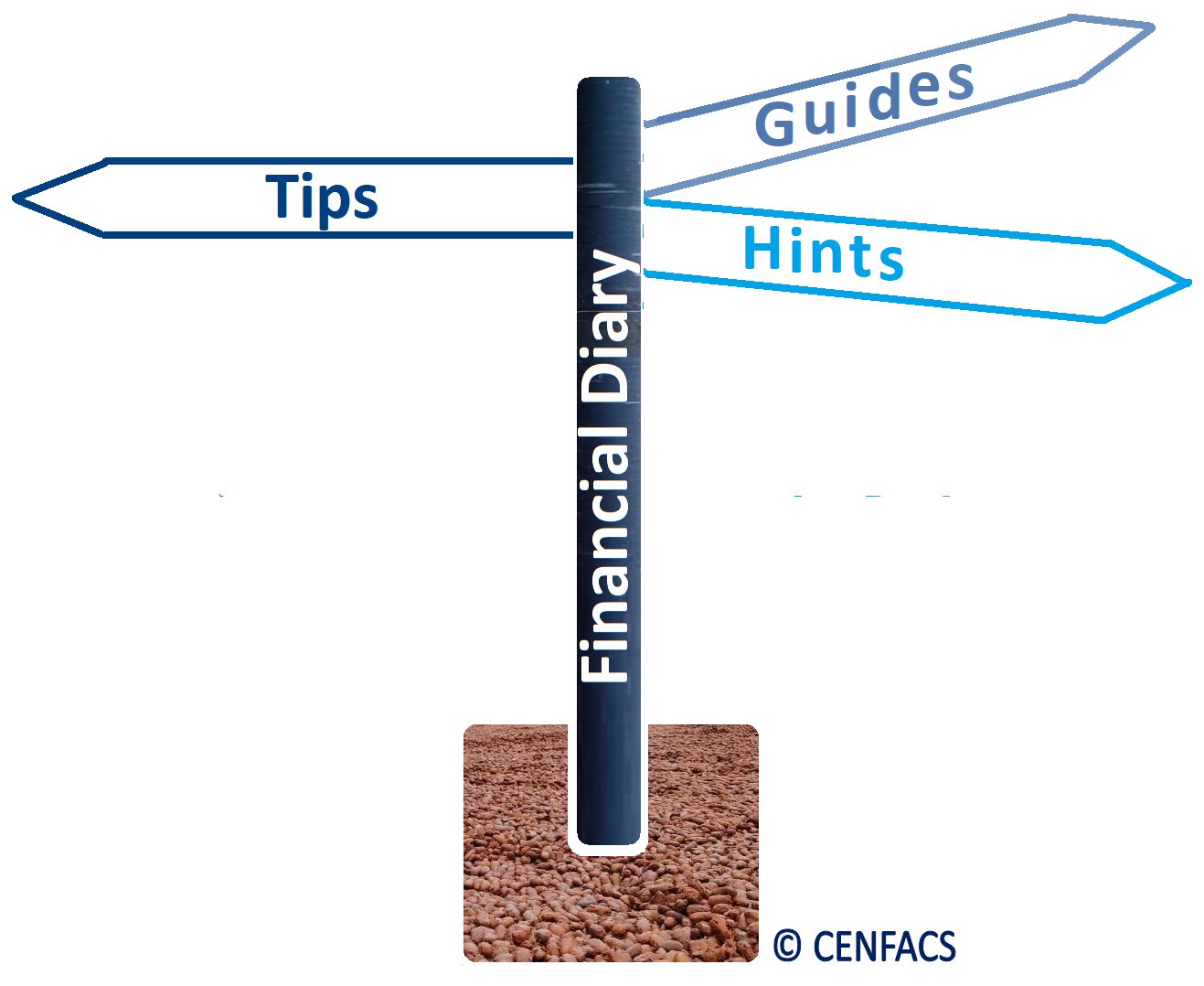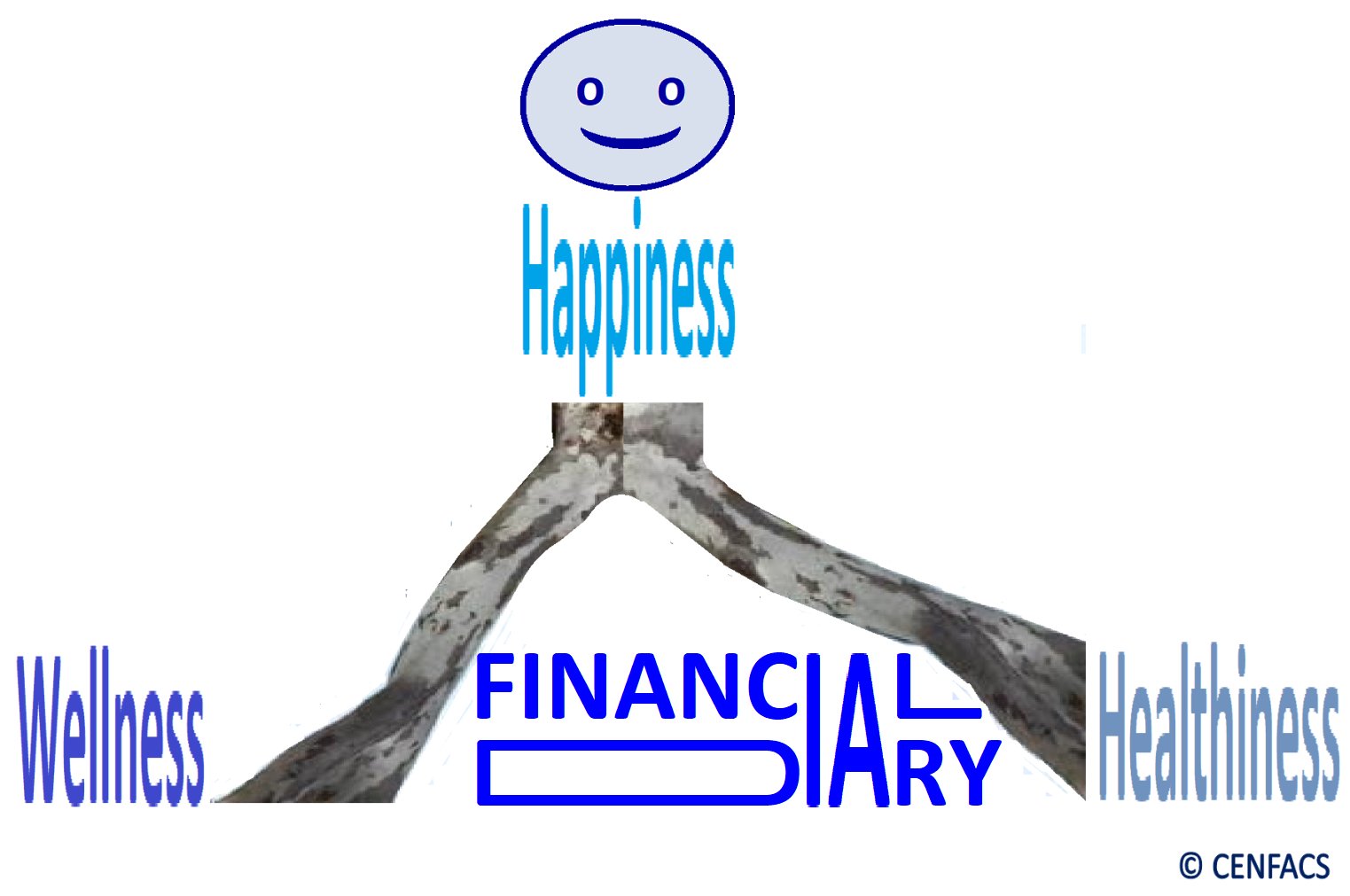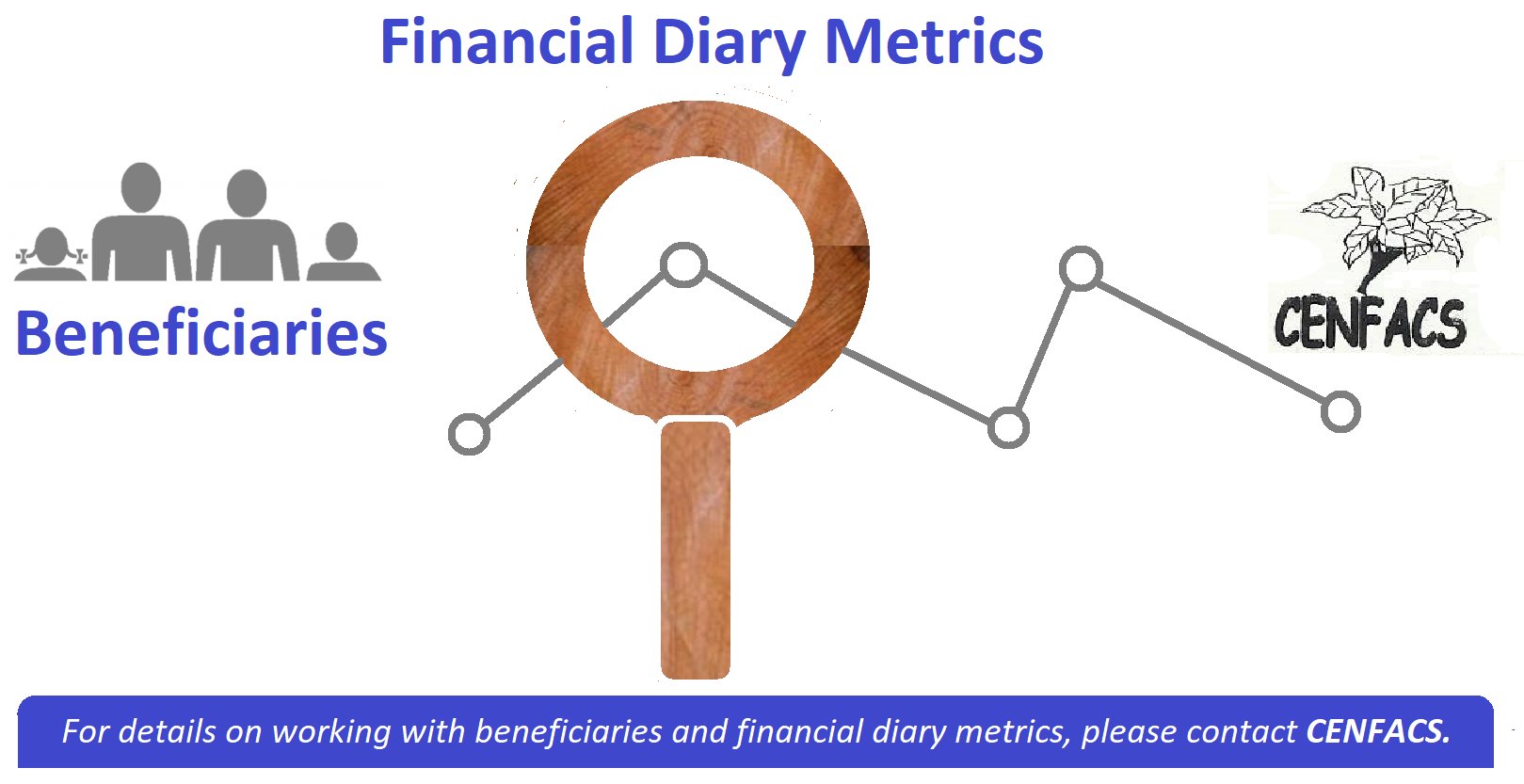Welcome to CENFACS’ Online Diary!
20 August 2025
Post No. 418
The Week’s Contents
• Financial Updates – In Focus for 2025 Edition: A Financial Diary for Your Household to Reduce Poverty
• Trend Analysis 2025 Activities from 20/08/2025
• Financial Trend Analysis for CENFACS
… And much more!
Key Messages
• Financial Updates – In Focus for 2025 Edition: A Financial Diary for Your Household to Reduce Poverty
Like any household, households making the CENFACS Community earn income and spend their income. However, when we asked how many of them run a financial diary, only a few of them were able to answer. Others amongst them did not even know what is a financial diary and whether a particular household can run it.
As a way of working together with households making our community, this year’s edition of Summer Financial Updates (SFU) will focus on way of running household financial diary and using it to update household finances, even to reduce poverty. But, what is a financial diary for a household?
• • Basic Understanding of a Financial Diary for a Household
It emerges from the financial literature that a financial diary for a household is detailed record of all income and expenses, both cash and non-cash, over a specific period. It is a tool used to track spending habits, identify areas where money is spent and ultimately help households manage their finances more effectively.
There are writers who prefer to use other terminology instead of financial diary. For instance the website ‘bestegg.com’ (1) speaks about money diary. According to ‘bestegg.com’,
“A money diary, also known as a spending journal, is record of your daily spending and financial decision. It is a detailed account of your financial habits, capturing both big and small purchases made daily”.
The financial diary we are talking about should not be confused with financial diaries used as a research method by social scientists to study how households manage their finances, particularly low-income or vulnerable people or households. This does not stop us to refer to what social scientists argue about financial diaries.
Financial diary does not only record daily financial transactions. It can also be used as a tool to reduce poverty.
• • Financial Diary as a Poverty Reduction Tool
Financial diary for a household will be used as tool to support households making our community over this Summer 2025 to reduce poverty. Indeed, according to ‘korzhykcapital.com’ (2),
“For poor people, money slips through their fingers like water. They themselves don’t understand where their money goes and in what quantities. They also don’t keep any track of their savings”.
This statement of ‘korzhykcapital.com’ may not be true for all the poor people. However, what is true is financial diary, which helps track individual’s or household’s daily financial transactions, can play a crucial role in poverty reduction by providing valuable insights into spending patterns, financial behaviours, and the impact of inclusion of this individual or household.
So, this year’s edition of Financial Updates does not only approach financial diary as an accounting tool/method for households’ financial management, but also and mainly as a means to help them reduce poverty as it provides an insightful way for understanding the type of poverty these households are experiencing and developing effective strategies to reduce it.
Further information about the 2025 Edition SFU is given under the Main Development section of this post where the summaries of its contents can be found.
• Trend Analysis 2025 Activities from 20/08/2025
We are continuing to work on the three types of Trend Analysis 2025 Activities, which are:
a) Trend Analysis for CENFACS as a Charity
b) User Activity Trend Analysis
c) Trend Analysis of the Poverty Reduction Market by following the Direction of Poverty Reduction.
This week, we are dealing with the third focuses of these 2025 Summer trend analysis activities; focuses which are given below.
• • Trend Analysis for CENFACS as a Charity – In Focus from Wednesday 20/08/2025: Service Demand and Delivery
To analyse service demand and delivery, we shall deal with these three elements: shifting needs, efficiency of service delivery and geographic distribution of service needs. Let us briefly explain them.
σ Shifting needs
The needs of CENFACS service users and beneficiaries can change. Analysing data on the types of services needed and the number of individuals seeking assistance can help CENFACS adapt its programmes to meet evolving community needs.
σ Efficiency of service delivery
Tracking Key Performance Indicators related to service delivery (e.g., number of people served, time taken to deliver services, cost per service, etc.) can help identify areas where CENFACS can improve its operational efficiency.
σ Geographic distribution of service needs
Analysing data on where services are most needed can help CENFACS optimise this service delivery and resource allocation.
So, the analysis of the above-mentioned three elements will help understand CENFACS‘ service demand and delivery.
• • User Activity Trend Analysis – In Focus from Wednesday 20/08/2025: Service Adoption and User Friction Analysis
User activity can be analysed via services that users and beneficiaries adopted and the frictions these users and beneficiaries had from CENFACS services. Perhaps the best way of approaching this trend analysis is to explain both service adoption and user friction analysis, as well as how to apply them in the context of CENFACS trend analysis.
• • What Is Service adoption?
The website ‘igi-global.com’ (3) explains that
“Service adoption is an individual’s decision to make a full use of a service, in our case, means actual use of mobile services”.
In other words, it is the engagement of service users to evaluate the service offered to them and adopt an attitude of acceptance or resistance, and then accept or reject the service. As the website ‘stratechi.com’ (4) puts it,
“Every new product category and technology has an adoption curve, which is the cumulative rate at which a population adopts a product, service, or technology over time”.
With the help of these perspectives on service adoption, we shall check if CENFACS has been able to use the knowledge of its services to deliver priority outcomes for CENFACS. This service will also include the checking of the service adoption curve stages and what they indicate. The curve divides consumers into five groups based on when they adopt new products, as stated by ‘amplitude.com’ (5). These groups are innovators, early adopters, early majority, late majority, and laggards. We shall check how CENFACS has incorporated adoption curve thinking into its service development. This service adoption lifecycle describes the adoption or acceptance of CENFACS new services and innovation in terms of working with the community.
• • What Is User Friction Analysis?
Let us start by explaining user friction. The website ‘whatfix.com’ (6) explains that
“User friction refers to any obstacle that stops users from completing a desired action inside an application, whether that is customer-facing users or internal application users. It is usually caused by structural elements that affect your product’s usability, such as poor UI design choices, branding technical resources, convoluted user flows, etc., and by the emotion your product triggers in users”.
Although this definition is given in a narrow context of business products offered to customers, it can be nevertheless expanded to include services provided charities like CENFACS.
Knowing what user friction is, it is possible to explain user friction analysis. According to ‘insight7.io’ (7),
“User friction analysis is about understanding the obstacles that user segments encounter”.
From these definitions of user friction and user friction analysis we shall check if CENFACS effectively conducted User Friction Analysis by defining user personas and grouping users based on behaviour patterns.
We shall as well verify if CENFACS used key metrics for measuring User Experience Friction like task completion rates, time on task, bounces rate, user satisfaction ratings.
We can finally examine if CENFACS dealt with user segments interactions, user interviews highlighting pain points, and quantitative data from session recordings.
All the above-mentioned tools and metrics are for user friction analysis.
• • Trend Analysis of the Poverty Reduction Market by Following the Direction of Poverty Reduction via the Integration of Nature and UNSDGs (United Nations Sustainable Development Goals) – In Focus from 20/08/2025: The Integration of Nature Goal A and UNSDG 14
This integration can be approached via the six links below.
Link 1: Between ecosystems maintenance and conservation of oceans, seas and marine resources
Maintaining healthy marine ecosystems is crucial for the conservation of oceans, seas, and their resources. Healthy ecosystems (such as coral reefs and mangrove forests) provide essential services like coastal protection, nursery grounds for fish, and carbon storage, which are vital for both the environment and human well-being. Conserving these ecosystems ensures the long-term sustainability of marine resources and the benefits they provide.
Therefore, healthy ecosystems are the foundation for a healthy ocean, and conservation efforts are essential for maintaining both the health of the ecosystems and the resources they provide.
Link 2: Between ecosystems enhancement and conservation of oceans, seas and marine resources
Healthy marine ecosystems are essential for sustaining healthy oceans and their resources. Enhancing marine ecosystems, like coral reefs and mangroves, provides crucial benefits for coastal protection, fisheries, and climate change mitigation, all of which contribute to the overall health and resilience of the marine environment. Conserving oceans and marine resources through measures like marine protected areas and sustainable fishing practices, ensures the long-term health and functionality of these ecosystems.
Briefly, protecting and restoring marine ecosystems directly benefit the health and resilience of oceans, while conserving marine resources ensures that these ecosystems can continue to provide vital resources for both humans and the environment.
Link 3: Between ecosystems restoration and conservation of oceans, seas and marine resources
Healthy ecosystems are crucial for supporting marine biodiversity and the services they provide. Restoration efforts, such as protecting and rehabilitating coastal habits like mangroves and coral reefs, directly contribute to conserving marine biodiversity and enhancing resilience of coastal communities to climate change. Likewise, successful marine conservation relies on restoring degraded ecosystems to their full potential.
So, ecosystems restoration and marine conservation are mutually reinforcing. Restoring degraded ecosystems can enhance biodiversity and resilience, while conservation efforts provide the necessary foundation for successful restoration and sustainable use of marine resources.
Link 4: Between ecosystems maintenance and the use of oceans, seas and marine resources
Maintaining healthy marine ecosystems is decisive for the sustainable use of oceans, seas, and marine. Healthy ecosystems provide essential services that support human well-being, including food production, climate regulation, and coastal protection. Sustainable use, in turn, ensures that these ecosystems can continue to provide these benefits for future generations.
By adopting sustainable practices and managing marine resources wisely, it is possible to ensure that these valuable ecosystems continue to support human well-being for generations to come.
Link 5: Between ecosystems enhancement and the use of oceans, seas and marine resources
Healthy ecosystems are important for the long-term health and productivity of oceans, seas, and marine resources. Sustainable use supports ecosystem health by reducing negative impacts and promoting restoration.
A healthy and resilient marine ecosystem is essential for sustainable use of oceans, seas, and their resources. Sustainable practices are crucial for protecting and enhancing the health of these vital ecosystems for the benefit of both present and future generations.
Link 6: Between ecosystems restoration and the use of oceans, seas and marine resources
Restoring degraded marine ecosystems enhances their capacity to provide essential services, supporting sustainable fisheries, coastal protection, and carbon sequestration, which are vital for both human well-being and the health of the planet.
Ecosystem restoration is not just about repairing past damage, but also about building a foundation for a sustainable future where oceans and marine resources can continue to support human well-being and ecological health.
So, it is possible to follow the Direction of Poverty Reduction via the Integration of Nature Goal A and UNSDG 14, via the above-mentioned links. As these links show, Nature Goal A and UNSDG 14 can have joint, even multiple effects on poverty reduction. Therefore, it is feasible to observe or follow the journey of poverty reduction via the integration of Nature Goal A and UNSDG 14, and their joint or multiple effect. To follow with us the direction of poverty reduction via the Integration of Nature and UNSDGs, please contact CENFACS.
For any queries and/or enquiries about the Trend Analysis Month, please do not hesitate to communicate with CENFACS.
• Financial Trend Analysis for CENFACS
This week, we are adding to Trend Analysis for CENFACS as a charity a financial trend analysis.
• • About Financial Trend Analysis for CENFACS
Financial Trend Analysis for CENFACS involves examining various financial aspects to understand CENFACS‘ financial position, risks, and the impact of trends on its operations. It is about analysing CENFACS financial data and statements, such as Receipts, Payments, and Surplus, to forecast future future financial performance.
• • Key Areas of Financial Trend Analysis for CENFACS
They include four main areas: revenue streams, expenditure management, forecasting and resilience. Let us briefly explain them.
~ Revenue streams
It is about understanding the different sources of revenues, such as donations, grants, members’ contributions; and how they fluctuate over time.
~ Expenditure management
It is about analysing the costs of services, controlling cash flow, and managing volunteers to ensure efficient resource allocation.
~ Forecasting
It involves proactively planning and analysing budgets to make informed decisions about resource allocation and fundraising efforts.
~ Financial resilience
It is about assessing CENFACS‘ ability to withstand financial pressures and adapt to changes in the market and regulatory environment.
Such analysis will use metrics to measure CENFACS financial performance.
• • Financial Trend Analysis Metrics
Key metrics fall under the areas of analysis below.
~ Revenue composition and reliability
Under revenue composition and reliability, we can mention metrics such as revenue breakdown, revenue reliability, average donation size, donor retention rate, and fundraising efficiency.
~ Programme and fundraising efficiency
We can use metrics like programme expenses ratio, fundraising efficiency ratio, growth of services, and beneficiary satisfaction.
~ Liquidity and debt management
We can work out current ratio, operating reserve ratio, liabilities as a percentage of total assets, and liability composition.
These metrics will help understand patterns and predict future outcomes by analysing historical data. They will also provide insights into beneficiary/user behaviour, service performance, and market trends; enabling data-driven decision for improvement and growth.
These metrics are useful in understanding patterns and predicting future outcomes.
• • Usefulness of Financial Trend Analysis of CENFACS
The trend analysis will help to forecast future demand, set fundraising goals, and make investment decisions. The analysis will assist to discern percentage of changes in the selected data and adjust CENFACS planning based on emerging trends in fundraising, expenses, and market conditions.
In brief, it will help CENFACS understand its performance, make informed decisions, adjust its financial planning based on emerging trends in fundraising, expenses and market conditions, while predicting future trends.
• • Have Queries and/or Enquiries about Financial Trend Analysis of CENFACS
For any queries and/or enquiries about Financial Trend Analysis of CENFACS, please do not hesitate to communicate with CENFACS.
Extra Messages
• Happiness, Healthiness and Wellness Journal – Creative Activity No. 5: Create Your Journal of Trust
• Summer 2025 Activities, Projects and Programmes: Help, Support and Assistance are AVAILABLE!
• Summer Triple Pack Is Still Running
• Happiness, Healthiness and Wellness Journal – Creative Activity No. 5: Create Your Journal of Trust
Polycrises of recent years may have perhaps made some people to become sceptical or lose trust in poverty reduction. Yet, there is a need or reason to keep faith in the reduction and end of poverty. There are grounds to believe that happiness, healthiness and wellness can always happen to those who are looking for them.
You can create your journal for any aspects of Summertime linked to trust. You can explain your experiences, feelings and thoughts in terms of happiness, healthiness and wellness about trust over this Summer. You can use surveys, metrics and data about trust to write your journal.
Your journal of trust can cover any of the following three areas:
~ trust in poverty reduction
~ trust in people or communities or institutions and initiatives that build, develop and sustain trust.
Let us give some examples of what one can include in each of these journals. But, before that it is better to highlight the relationships between happiness and trust, between healthiness and trust, between wellness and trust.
• • Relationships between Happiness and Trust, between Healthiness and Trust, between Wellness and Trust
• • • Relationships between Happiness and Trust
There could be link between happiness and trust. There is a number of resources that mention this link. One of them is ‘happyondemand.com’ (8) that explains this:
“Studies indicate that trust is a primary prediction of relationship satisfaction and happiness. When trust is present in a relationship, individuals feel safe, secure, and valued. This fosters a positive emotional environment that contributes to happiness and well-being”.
From this explanation, one can explain their experiences, feelings and thoughts in terms of happiness about trust over this Summer.
• • • Relationships between Healthiness and Trust
There are many real life stories showing that the relationships between healthiness and trust can happen.
For example, Nguyen and Pervan (9) in the literature review and hypothesis development regarding ‘The Relationship between Food Healthiness, Trust and the Intention to Reuse Food Delivery Apps’ written by Kyung-A Sun and Joonho Moon, they explain that food healthiness (i.e., consumers’ perceptions of whether food in the market promotes health conditions) can be associated with consumer trust (that is, assessment of consumer perception of corporate social responsibility).
From the above example and other ones, one can explain their experiences, feelings and thoughts in terms of healthiness about trust over this Summer.
• • • Relationships between Wellness and Trust
There is evidence on the association between trust and individual well-being. Trust plays an important role in promoting well-being.
One can provide evidence by explaining their experiences, feelings and thoughts in terms of wellness about trust over this Summer.
One can go further in their journal of trust by writing on poverty reduction, people and communities they belong to, initiatives to develop trust, projects to build forward together trust, etc.
• • Journal of Trust in Poverty Reduction
You can record your thoughts, sentiments, feelings, experiences, souvenirs and memories about the following:
promoting trust where trust is lost; dealing with disinformation and distrust about poverty reduction; struggling to believe or cope with trust in poverty reduction, etc.
• • Journal of Trust in People and Communities
You can record your thoughts, sentiments, feelings, experiences, souvenirs and memories about the following:
correcting inaccuracies and misinformation; stopping the spread of false information or the pollution news/information within your community/network; building trust with people through transparency; speaking about the most trusted person in your community; talking about faith in your social networks (e.g., family and friends), educating people about trust, following trusted media and networks, etc.
• • Journal of Initiatives to Develop Trust
You can record your thoughts, sentiments, feelings, experiences, souvenirs and memories about the following:
building and protecting standards of trust; rebuilding trust in each other; explaining interactive initiatives you have taken to protect and defend trust; monitoring and collecting feedbacks to track changes in trust, etc.
• • Journal of Projects to Build Forward Together Trust
You can record your thoughts, sentiments, feelings, experiences, souvenirs and memories about the following:
not supporting a return to the endemic structural disadvantages and inequalities; transforming your relationship with nature; dismantling structures of discrimination that disadvantage poor people; and building on the moral and legal framework of human rights that places human dignity at the heart of policy and action, building upon progress made on trust, moving forward with trust, etc.
The above four areas are just an example of the many about trust and journals of trust. If you have a different area of interest in trust that you would like to write on for your Summer journal, please feel free to do it.
• • Impact Record and Share of Your Journal of Trust
You can impact record your thoughts, sentiments, feelings, experiences, souvenirs and memories in relation to happiness, healthiness and wellness about trust over this Summer. This can be recorded in your journal and be shared by the end of Summer 2025.
To impact share the contents of your journal of happiness, healthiness and wellness relating to happy, healthy, good and trustful Summer 2025; as well as to help build a better Summer holiday experience, you can contact CENFACS.
• Summer 2025 Activities, Projects and Programmes: Help, Support and Assistance are AVAILABLE!
We believe that everybody is enjoying their Summer break wherever they are and whatever they are doing, despite the lingering effects of the polycrises, extreme temperatures and the cost-of-living crisis.
We also hope that those who are working over this Summer are getting on well with their work while finding some space to accommodate and enjoy the good weather of Summer.
We finally trust that Summer 2025 Happiness, Healthiness and Wellness Projects, including other Summer activities and programmes we have offered so far, are meeting the community’s need to well, happily and healthily pass this Summer.
For those who need any help, support and assistance regarding any of the aspects of the Happiness, Healthiness and Wellness Projects or any other Summer activities or programmes which are on offer, they should not hesitate to contact CENFACS.
We would like to reiterate our wish to all multi-dimensional Poor Children, Young People and Families of Happy, Healthy, Good, Vulnerability-free, Peaceful, Safe and Sustainable Summer Days.
• Summer Triple Pack Is Still Running
Our Summer Triple Pack made of Track, Trip and Trends continues this week. The key message we would like to get across this Triple Pack is to try to help reduce poverty by undertaking any of these three activities: running, visiting projects and analysing trends. Let us make some reminding points about each of them.
• • Healthy, Safe and Net Zero Track to Help Reduce Poverty
This activity (Restoration Activity 8.1) of the pack is about Safely and Healthily Running 2.5 miles (nearly 4 km) with people in need of restoration to create user-generated information giving opportunity while talking to them during the run and supporting them to improve their coping strategies for their good wellness or their restoration plans.
For those who have completed their 2.5 miles of running with people, please do not hesitate to share with us your experience. This activity is also performed under August 2025 Restoration Year/Project (Activity 8.1).
For those who are deprived to physically run, they can virtually run to help reduce poverty with CENFACS. Among them are people who may be experiencing handicap to do physical activity of running to help reduce poverty. One could include the following in their list:
People or parents caring for very young children, pregnant women, elderly people, disable people, those who are not physically fit or mobile to run, those who do not have opportunity to physically run, etc.
If you are organising this kind of virtual activity or event, let us know. It is also better to advise us that the people participating in the virtual run are the physically deprived ones we have listed above or they have a serious handicap prohibiting them from undertaking any physical engagement.
• • Virtual or In-person Trips or Tours of 3 Restoration Projects or Activities
As part of Restoration Year/Project Activities of the month and Restoration Activity 8.2, we have suggested to Undertake Virtual or In-person Visits or Tours of 3 Restoration projects or activities; projects or activities based on restoration facts, information and skills acquired through experience or education, and which use restoration methodology, techniques and tools to support people this Summer 2025
These virtual visits are not only online recreational activities. They are also a learning and development opportunity.
Furthermore, Virtual Trip as part of our Summer Triple Pack includes field work research in Africa and anywhere else in the context of poverty relief and sustainable development projects.
For those who are having or have had these experiences and results of field work research, please do not hesitate to share them.
• • Online Search to Find 6 Trends in Poverty Reduction for Projects
As part of CENFACS’ Restoration Year and Project and Activity 8.3, we have asked to those who can to carry out online search to find 6 Trends in poverty reduction for projects that are helping people to restore things or their lives/livelihoods.
If anyone has something to share about their online searches relating to the 6 Trends, they should not hesitate to communicate with CENFACS.
The above mentioned Summer Triple Pack can be contextualised by considering the lingering impacts of the polycrises, extreme temperatures and the damaging effects of the cost-of-living crisis.
Message in English-French (Message en Anglais-Français)
• CENFACS’ be.Africa Forum E-discusses Media Choice, Information Consumption and Poverty Reduction
Every African has the right to choose the media that interests them and to consume good information, especially if that media or consumption will help them solve their problems such as poverty. However, since we are in an era of disinformation, information pollution, mistrust and defiance of traditional media, and false information, there are reasons to question a number of points such as:
σ Can vulnerability to misinformation lead to vulnerability to poverty?
σ How can we kill false information at the source without undermining all efforts to reduce poverty?
σ How can we strengthen the truth of facts for the purpose of poverty reduction?
σ How can we promote the effective and efficient use of social media and social networks in the interest of poverty reduction?
σ How can we reinvent the role of journalism to combat misinformation and enhance the fight against poverty in Africa?
The above questions are the subject of discussion within the Forum ‘A Better Africa’ of CENFACS.
Those who may be interested in this discussion can join our poverty reduction pundits and/or contribute by contacting CENFACS be.Africa Forum, which is a forum for discussion on poverty reduction and sustainable development issues in Africa and which acts on behalf of its members by making proposals or ideas for actions for a better Africa.
To contact CENFACS about this discussion, please use our usual contact address on this website.
• Le Forum ‘Une Afrique Meilleure’ de CENFACS discute en ligne du Choix des Médias, la Consommation d’Informations et la Réduction de la Pauvreté
Chaque Africain a le droit de choisir les médias qui l’intéressent et de consommer de bonnes informations, surtout si ces médias ou cette consommation peuvent l’aider à résoudre ses problèmes tels que la pauvreté. Cependant, comme nous sommes à une époque de désinformation, de pollution informationnelle, de méfiance et de défiance envers les médias traditionnels, ainsi que de fausses informations, il y a des raisons de remettre en question un certain nombre de points tels que :
σ La vulnérabilité à la désinformation peut-elle entraîner une vulnérabilité à la pauvreté ?
σ Comment pouvons-nous éliminer la désinformation à sa source sans compromettre tous les efforts pour réduire la pauvreté ?
σ Comment pouvons-nous renforcer la vérité des faits dans le but de réduire la pauvreté ?
σ Comment pouvons-nous promouvoir l’utilisation efficace et efficiente des médias sociaux et des réseaux sociaux dans l’intérêt de la réduction de la pauvreté ?
σ Comment pouvons-nous réinventer le rôle du journalisme pour lutter contre la désinformation et renforcer la lutte contre la pauvreté en Afrique ?
Les questions ci-dessus sont l’objet de discussions au sein du Forum ‘Une Afrique Meilleure’ de CENFACS.
Ceux ou celles qui pourraient être intéressé(e)s par cette discussion peuvent se joindre à nos experts en réduction de la pauvreté et/ou contribuer en contactant le ‘me.Afrique’ du CENFACS (ou le Forum ‘Une Afrique Meilleure’ de CENFACS), qui est un forum de discussion sur les questions de réduction de la pauvreté et de développement durable en Afrique et qui agit au nom de ses membres en faisant des propositions ou des idées d’actions pour une Afrique meilleure.
Pour contacter le CENFACS au sujet de cette discussion, veuillez utiliser nos coordonnées habituelles sur ce site Web.
Main Development
• Financial Updates – In Focus for 2025 Edition: A Financial Diary for Your Household to Reduce Poverty
The 2025 Edition of Summer Financial Updates (SFU) approaches financial diary both as an accounting tool/method for the tracking of daily financial transactions of households and as a means to help them reduce poverty. The edition provides an insightful way for understanding the type of poverty these households are experiencing and developing effective strategies to reduce it.
To enable readers extirpate the contents of this edition, we have provided below the key highlights about it.
• • Key Highlights of This Year’s Edition of Summer Financial Updates
The following headings contain the main points highlighted in this Year’s SFU:
∝ What is financial diary?
∝ Financial diary as a the foundation of household economic activity
∝ Contribution of financial diary to household poverty reduction
∝ Working with households on financial diary as an accounting tool
∝ Guides, tips and hints to better write your household financial diary
∝ Relationships between happiness and financial diary, between healthiness and financial diary, between wellness and financial diary
∝ Improving the relationship between financial diary and poverty reduction
∝ Working with users through financial diary metrics to achieve the goal of poverty reduction
Let us unpack the above headings.
• • What Is Financial Diary?
Financial diary is a tool that tracks people’s or households’ income, the amount of monthly investments, expenses, assets, and in doing so providing a general financial summary of the month.
There are authors who prefer to use other terminology instead of financial diary. For instance the website ‘bestegg.com’ (op. cit.) speaks about money diary. According to ‘bestegg.com’,
“A money diary, also known as a spending journal, is record of your daily spending and financial decision. It is a detailed account of your financial habits, capturing both big and small purchases made daily”.
The financial diary we are talking about should not be confused with financial diaries used as a research method by social scientists to study how households manage their finances, particularly low-income or vulnerable people or households. But, this does not us to do some incursions to what social scientists argue about financial diaries and their findings about them.
The financial diary we are dealing with here is the written record of households’ daily financial transactions or events in their financial life which underpin their economic activities.
• • Financial Diary as a the Foundation of Household Economic Activity
Like any economic agents, households produce and consume goods and services. Household financial diary can help capture the activities of producing and consuming goods and services within households. This dairy can be the basis on which household economic activity depends.
To explain how financial diary can be the foundation of household economic activity, it is better to know household economy. The latter helps to understand how households feed themselves, earn the cash they need, what assets they hold and opportunities open to them, what the constraints they face, and the options open to them at times of crises and shocks (10).
So, running a financial diary can help households to better deal with these economic activities.
• • Contribution of Financial Diary to Household Poverty Reduction
A financial diary can provide valuable insights into spending patterns, financial behaviours, and the impact of financial inclusion. This data can provide an indication of the type of poverty that a particular household may be going through.
Financial dairy can thus contribute to poverty reduction via the understanding of household financial flows and needs (which can show spending patterns and reveal hidden vulnerabilities), knowledge on household financial inclusion (by identifying barriers to access), the improvement of poverty measurement, and fostering empowerment and participation.
One thing is to know what households are going through; another thing is to work with them so that they can navigate their way to poverty reduction in a frictionless way if they are facing poverty.
• • Working with Households on Financial Diary as an Accounting Tool
Financial diary as a financial management or accounting tool will help households to track their income, investment, expenses, assets, as well as to provide a summary of the month (that is, the amount of the capital they have and how it has changed over the past month). Through this tool, we hope to work with them so that they can
σ better track their income and expenses
σ identify areas of improvement regarding their budgeting and financial planning
σ go beyond simple budgeting to analyse their financial behaviour
σ and above all further reduce poverty linked to the lack of understanding of a financial diary.
Working with households implies providing guides, tips and hints on financial diary.
• • Guides, Tips and Hints (GTH) to Better Write Your Household Financial Diary
GTH includes help, advice, counselling, signposts, referrals and pieces of useful information that CENFACS can provide to its members/users/project beneficiaries so that they can write their own financial diary and own the process of controlling their finances.
GTH also includes information on technologies to better write and fill your financial diary.
For instance, one can use AI (Artificial Intelligence) free app Snoop to help them track their spending, manage their bills, set monthly budgets and calculate how much they would like to save. Similarly, one can refer to AI-powered personal finance information chatbot that searches articles and news stories to answer their money-saving questions.
These technologies can people in dealing with their financial diary and other financial matters like financial decision-making processes.
For those members of our community, users and project beneficiaries who are in need of guides, tips and pieces of information about producing and completing a financial diary, they can contact CENFACS.
For those who would like to access the GTH about their financial diary, they are welcome to communicate with CENFACS.
• • Relationships between Happiness and Financial Diary, between Healthiness and Financial Diary, between Wellness and Financial Diary
A good handling of your financial diary can bring happiness, just as it can help achieve healthiness and wellness. In other words, there are relationships between happiness and financial diary, between healthiness and financial diary, between wellness and financial diary. Let us highlight these relationships.
• • • Relationships between happiness and financial diary
Financial diaries offer valuable insights into the relationship between financial well-being and happiness by revealing how spending and saving habits correlate with overall life satisfaction. By tracking household daily financial transactions and relating them to subjective well-being, financial diaries can help identify patterns and connections between spending choices and emotional states.
• • • Relationships between healthiness and financial diary
Financial diaries can track an individual’s or household’s income, spending, and saving patterns over time. Because of that, they can provide impactful insights into how financial situations fluctuate and how they relate to other aspects of life, including health.
So, financial diaries can reveal the intertwined relationships between financial well-being and health, and help individuals/households understand how to improve both their financial and health outcomes.
• • • Relationships between wellness and financial diary
The overall wellness requires the adoption of practices – like physically exercising more and eating healthier foods – to help you live a better and long life. Financial diaries can help to detect if these aspects of wellness are reflected in your income and spending habits. In other words, to stay well, one may need the components of wellness which are physical, emotional, intellectual, social and spiritual. Financial diaries can help track these wellness elements in one’s income and spending habits and patterns.
The above shows that there are correlations between happiness and financial diary, between healthiness and financial diary, between wellness and financial diary. These correlations can be quantitative and qualitative. The strengths and directions of these correlations depend on each individual or household in terms of the proportion of their budgets they allocate to happiness, healthiness and wellness.
• • Improving the Relationship between Financial Diary and Poverty Reduction
There is a recognition that financial diary contributes to poverty reduction. Because of that, it is possible to increase this contribution as well as to improve the relationship between poor people’s or households’ financial diary and poverty reduction. In other words, “households are considered to be below the UK poverty line if their income is below 60% of the median household income after housing costs for that year”, according to the Trust for London (11).
While this income-based measure is good to get an idea about income poverty, it may not be enough in terms of poverty reduction strategies. Financial diaries may offer a holistic view of poverty by capturing the complexities of poverty in incorporating spending patterns, access o resources and financial vulnerabilities. This capture and incorporation can open up the possibilities to reduce poverty or at least to improve the link between financial diary and poverty reduction.
• • Working with Users through Financial Diary Metrics to Achieve the Goal of Poverty Reduction
The all purpose of SFU is not to provide theories or descriptions or assumptions or simply talks. Instead, SFU as a resource is designed to capacitate the CENFACS Community to address challenging issues they face. In this case, the challenging issue is how to use financial diary to reduce household poverty.
In this exercise of addressing challenges, our members are not let alone. CENFACS can work with them to enhance their financial diary writing and analytical skills so that they can take control of their finances, make informed decisions and move towards achieving the goal of poverty reduction. This exercise could involve handling financial diary metrics. Among these metrics, we can mention the following key ones:
~ Income (total earnings from sources such as salary, investments, etc.)
~ Expenses (like relating to housing, food, transportation, etc.)
~ Saving ratio (captures both the disposable income that households do not spend on consumption, and changes in the equity households have in pension funds)
~ Cash flow (the movement of money in and out of the household’s accounts)
~ Net income (income after taxes and other deductions)
~ Net worth (total assets minus total liabilities)
~ Debt-to-income ratio (ratio of monthly debt payment to monthly income).
These metrics can be monitored to track progress, identify spending patterns, assess household financial health and help these households make informed financial decisions.
CENFACS can work with them to accomplish specific tasks to deal with their financial diary, in particular to accompany them in their journey to handle financial diary so that they can better track their daily transactions, get valuable insights into their spending patterns and financial behaviours, understand the type of poverty they may be facing and develop an effective poverty reduction strategy.
CENFACS can conduct needs assessment with them and find out whether we can employ financial diary tools and metrics that can enable them to track their daily transactions, get insights and find poverty reduction solutions to their problems. We can also help them to understand and apply these tools and metrics in their real life.
For those who need help with their financial diaries, we can work together and help them track their income, expenses, savings, debt, and other financial transactions over time, whether through a physical notebook or a digital app or even a spreadsheet.
The above highlights are just a selection of some of matters raised in this year’s SFU.
For those who need help to sort out or review their financial diary, they are welcome to contact CENFACS.
Likewise, those who want to read this year’s resource of SFU beyond the aforementioned highlights, they can as well contact CENFACS.
_________
• References
(1) https://www.bestegg.com/blog/what-is-money-diary-and-how-to-keep-one-to-improve-your-finances/ (accessed in August 2025)
(2) https://korzhykcapital.com/article/why_you_should_keep_a_financial_diary (accessed in August 2025)
(3) https: //www.igi-global.com/dictionary/theories-behind-mobile-marketing-research (26576#:~:text= (accessed in August 2025)
(4) https://www.stratechi.com/adoption-curves/#:~text=… (accessed in August 2025)
(5) https://amplitude.com/explore/product/product-adoption-curbe (accessed in August 2025)
(6) https://whatfix.com/log/user-friction/ (accessed in August 2025)
(7) https://insight7.io/how-to-track-experience-friction-across-different-user-segments/ (accessed in August 2025)
(8) https://happyondemand.com/happiness-in-relationships/ (accessed in August 2024)
(9) https://www.mdpi.com/2304-8158/13/6/890 (accessed in August 2024)
(10) https://foodeconomy.com/what-is-hea/ (accessed in August 2025)
(11) https://trustforlondon.org.uk/data/poverty-thresholds/#:~:text=… (accessed in August 2025)
_________
• Help CENFACS Keep the Poverty Relief Work Going This Year
We do our work on a very small budget and on a voluntary basis. Making a donation will show us you value our work and support CENFACS’ work, which is currently offered as a free service.
One could also consider a recurring donation to CENFACS in the future.
Additionally, we would like to inform you that planned gifting is always an option for giving at CENFACS. Likewise, CENFACS accepts matching gifts from companies running a gift-matching programme.
Donate to support CENFACS!
FOR ONLY £1, YOU CAN SUPPORT CENFACS AND CENFACS’ NOBLE AND BEAUTIFUL CAUSES OF POVERTY REDUCTION.
JUST GO TO: Support Causes – (cenfacs.org.uk)
Thank you for visiting CENFACS website and reading this post.
Thank you as well to those who made or make comments about our weekly posts.
We look forward to receiving your regular visits and continuing support until the end of 2025 and beyond.
With many thanks.
